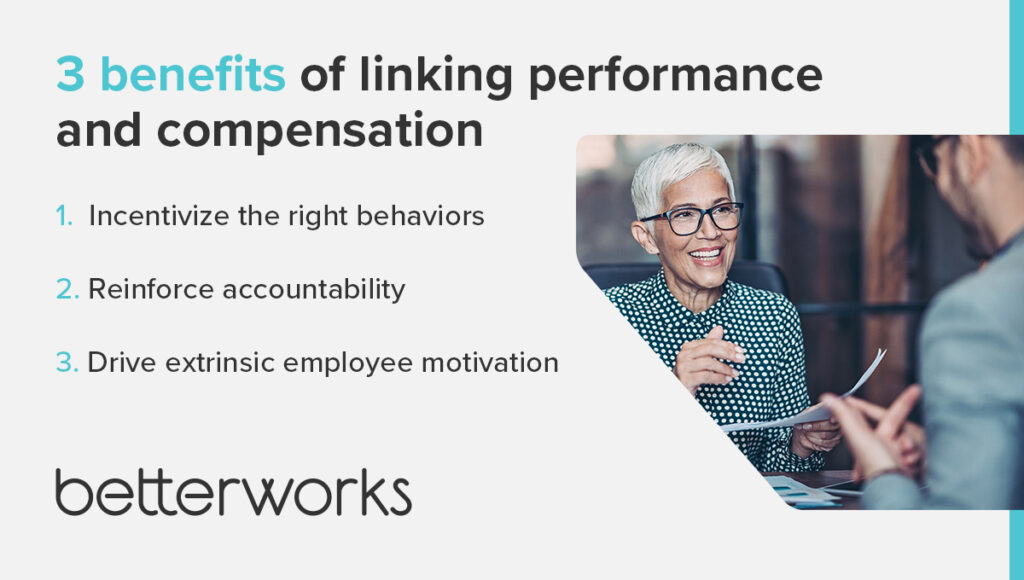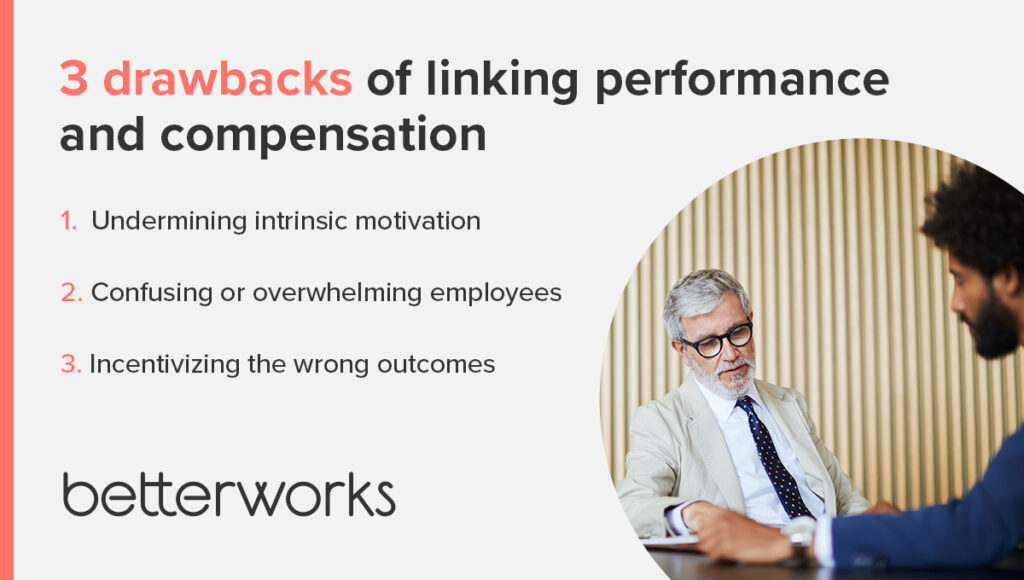- Why many companies link compensation and performance
- 3 elements of performance management, and how they align with pay
- 3 benefits of linking performance management and compensation
- 3 drawbacks of linking performance management and compensation
- 5 factors to consider when before implementing pay-for-performance compensation
- Make pay for performance work for you
Performance data has become the go-to resource for managers when determining pay increases, bonuses, and other financial rewards. Tying compensation to performance management is a widely adopted tactic driving pay decisions as part of an organization’s compensation strategy — but it can be challenging to do it fairly and effectively.
Our 2024 State of Performance Enablement report reveals a stark disconnect between how business leaders perceive performance management processes and how employees experience them. Nearly half (44%) of employees we surveyed gave their organizations’ performance management processes a failing grade, compared to only 12% of executives and HR professionals.
With employees losing faith in performance processes, we need to be careful how we tie compensation to performance management. There are many ways of tying compensation to performance management for both individual and team performance. Explore the benefits and drawbacks of linking compensation to performance, and learn how to link performance to pay in ways that make sense for your workforce.
Why many companies link compensation and performance
Compensation structures typically vary by level: Most executives receive bonuses based on business unit and organizational performance, while leaders and managers typically receive compensation in the form of bonuses for their employee’s performance. For individual contributors, linking an employee’s or a team’s compensation to performance is a common strategy in many organizations. The primary reason is to align an employee’s or team’s efforts with the company’s goals, ensuring everyone is working toward the same business objectives. This alignment can lead to improved business results, as employees are more motivated to achieve their targets when financial rewards are at stake.
Performance-based pay is common, but there are right and wrong ways to implement it. “Most organizations, since World War II, essentially, have done pay for performance — and they’re not going to stop,” says Caitlin Collins, organizational psychologist and program strategy director at Betterworks. “But there is a good way to approach it and a bad way to approach it.”
When implemented effectively and intentionally, performance-based compensation can drive better outcomes, both in terms of individual performance and at the business level.
“Most organizations, since World War II, essentially, have done pay for performance — and they’re not going to stop. But there is a good way to approach it and a bad way to approach it.”
Caitlin Collins, Organizational Psychologist and Program Strategy Director, Betterworks
3 elements of performance management, and how they align with pay
Financial compensation, linked to employee, team, and organizational performance, is a standard approach to rewarding managers and employees for driving business goals forward. However, aligning pay to any program sends a strong signal about what business leaders value and want to incentivize in the workforce.
Here are some common elements of an employee performance management program, and the best ways to use performance outcomes to inform pay decisions.
Goals and objectives
Goals and objectives define what employees need to achieve within a specific period. These are generally set and evaluated as part of the performance review process. Goals, if aligned with compensation, can drive employees to focus on key business priorities. Ensuring that goals are measurable and achievable is essential for this system to work effectively.
Frequently, Caitlin says, employees prioritize what is most meaningful to their growth and job stability. When competing priorities exist, employees will struggle to prioritize goals that don’t influence or contribute to their performance ratings and compensation opportunities. Tying goals to performance and compensation signals how important working toward those goals is to the business. However, she cautions against rewarding goal achievement, and instead suggests looking at the impact of goal achievement, how aspirational their goals are, and the behaviors and habits they picked up in service of their goals.
Performance reviews
Performance reviews are comprehensive evaluations of an employee’s overall job performance. They focus on assessing strengths and weaknesses over the past year, identifying areas for development for the coming year, and providing feedback on various aspects of an employee’s work.
Tie performance reviews to pay, Caitlin says, by looking at not just what employees achieve but also how they achieve it. Behaviors aligned with your company values underscore business impact, so you want to reward the right behaviors.
Many companies encourage collaboration, for example, so an employee’s performance review should reflect specific instances when they collaborated with colleagues to achieve better performance. This way, pay rewards not just goal impact but also positive actions that help the business grow.
Performance ratings
Performance ratings are more specific, quantitative assessments. They usually involve assigning a score or rating to an employee based on how effectively they’ve met performance expectations over a certain period. Most organizations use a performance ratings system to identify top performers and low performers across the workforce.
Typically, Caitlin says, performance ratings flow into downstream processes like determining promotions or compensation packages, often directly influencing variable pay decisions such as merit increases and bonuses.
But if you’re going to tie pay to performance ratings — and most organizations do — those ratings must clearly and objectively reflect how well employees do their jobs, both in terms of the impact of what they’ve achieved and how they achieved it. By focusing on these key areas, employees stay motivated to work on what truly matters, helping the business succeed.

3 benefits of linking performance management and compensation
Tying together an employee’s compensation with their performance offers several benefits that can enhance overall organizational effectiveness.
Incentivize the right behaviors
Linking compensation to performance helps incentivize behaviors that align with the company’s goals. Employees are more likely to engage in activities that drive business success when they know their efforts will be financially rewarded.
“Everything always comes down to: What do you need people to do? And are you reinforcing the right behaviors to get there?” Caitlin says.
Rather than simply rewarding a sales team based on quarterly outcomes, for example, take a deeper look at the behaviors displayed by top sales team members. What communication habits have they developed to help them achieve their sales targets? From there, you can roll out development opportunities based on those behaviors, and take those into account to drive repeatable and long-term success when assessing performance and doling out rewards across the sales team.
Caitlin further suggests incorporating manager and leadership behaviors into performance processes, since managers play a key role in goal-setting and driving desired employee behaviors. For pay-for-performance programs to work, you need to reward the full range of behaviors that contribute to business success — not just individual outputs or outcomes.
Reinforce accountability
When compensation is linked to performance, employees are held accountable for driving business impact. This accountability ensures that employees remain focused and dedicated to working toward their goals, as their performance directly impacts their financial rewards.
To achieve this benefit, their goals need to tie, directly or indirectly, to business outcomes. “Maybe I have a development goal that only impacts me,” Caitlin says. “But is it strategically aligned to help me improve how I deliver business results?” A development goal related to improving negotiation skills, for example, can help a sales team member drive broader strategic impact through their personal improvement.
Drive extrinsic employee motivation
Financial incentives tied to performance can significantly boost employee motivation. Knowing that exceptional performance will lead to better compensation can drive employees to go above and beyond in their duties, fostering a culture of excellence within the organization.
Additionally, a well-designed compensation program motivates employees to focus on what’s most important. People will naturally prioritize work tied to their rewards, growth potential, and job security. By structuring your compensation program with intention, you send a clear message around what the business considers to be most important — and motivate employees to focus on achieving that.

3 drawbacks of linking performance management and compensation
Despite its benefits, linking compensation to performance management can also have drawbacks that need careful consideration.
Undermining intrinsic motivation
One major drawback is the potential to undermine intrinsic employee motivation. When employees focus solely on financial rewards, they may lose sight of the inherent satisfaction that comes from doing their jobs well. This shift can lead to decreased job satisfaction and engagement over time.
However, that doesn’t have to be the case — and it all comes back to how you structure your pay-for-performance program. “We can use pay for performance to align with intrinsic motivations,” Caitlin says, “if we’re pulling on the right levers that drive the right behaviors.”
By focusing on how employees achieve their goals, you can help them align their personal and professional development with achieving business impact. Employees will not only receive monetary rewards but also the satisfaction of working to improve themselves.
“We can use pay for performance to align with intrinsic motivations, if we’re pulling on the right levers that drive the right behaviors.”
Caitlin Collins, Organizational Psychologist and Program Strategy Director, Betterworks
Confusing or overwhelming employees
The complexity of performance-based compensation systems can confuse or overwhelm employees. “Overly complicated pay structures, for example, could potentially confuse employees and undermine performance goals,” Caitlin says. If performance expectations or the criteria for earning rewards are not clear, employees might struggle to understand how to achieve their financial goals, leading to frustration and decreasing their motivation.
Performance-based pay systems work best when they are easy for employees to understand. Caitlin suggests applying clearly defined pay structures and straightforward communication so employees aren’t left questioning how their performance impacts their pay.
Incentivizing the wrong outcomes
Tying compensation to performance management has the potential to incentivize achieving outcomes in an undesired way, if it’s not structured properly to reward the full range of desired behaviors. Employees might focus on short-term gains or manipulate metrics to achieve their targets, rather than engage in behaviors that lead to long-term success.
Specifically, Caitlin says, directly tying ratings or goal progress to pay could cause employees to “game the system” and focus only on those metrics rather than overall performance. This misalignment can harm the organization in the long run.

5 factors to consider when before implementing pay-for-performance compensation
Performance-based pay has great potential but can also introduce new risks into an organization. Before implementing a pay-for-performance system in your business, you need to consider several factors to guarantee that it’s fair and effective.
Ask yourself these questions to determine if pay-for-performance is right for your business.
What are you trying to motivate employees to do?
Clearly define the behaviors and outcomes you want to motivate. Make sure that these align with your company’s strategic goals and values. Understanding the desired behaviors you need to motivate to drive success will help you design a compensation system that motivates the right actions.
Are you rewarding employees for driving business results?
Make sure that your compensation system rewards employees for contributing to the company’s success. This involves linking rewards to measurable business outcomes rather than just individual performance metrics.
How will you determine pay increases?
Establish clear criteria for determining pay increases. This might include performance reviews, goal impact based on job role, and other relevant metrics. Transparency in this process is crucial for maintaining employee trust and motivation.
How will you determine and distribute bonuses?
Design a fair and transparent bonus distribution system. Consider both individual and team performance, and make sure that the criteria for earning bonuses are well-communicated to all employees. Workplace transparency helps prevent confusion and fosters a sense of fairness.
Is compensation tied to internal mobility?
Consider how your organization’s compensation strategy affects internal mobility. Make sure that high performers have opportunities for advancement and that their compensation reflects their potential for future roles within the company. This approach can help retain top talent and encourage ongoing employee development. The opportunity to develop and advance should, ideally, be made available to all employees, not just those deemed “high performers.” By enabling all employees to learn new skills and stretch themselves, and by making the mobility process clear to all, you can improve organizational capacity and promote retention company-wide.
Make pay for performance work for you
Linking pay to performance is a smart but intricate way to boost business success. When you grasp both the upsides and downsides, you can create systems that inspire your team, align their goals with the company’s, and support long-term growth. By focusing on key factors and being clear and transparent, you can make sure your performance-based pay system is fair and effective.
Want to learn more? Learn how to implement performance enablement in your workplace.
Align your compensation with a performance enablement model







